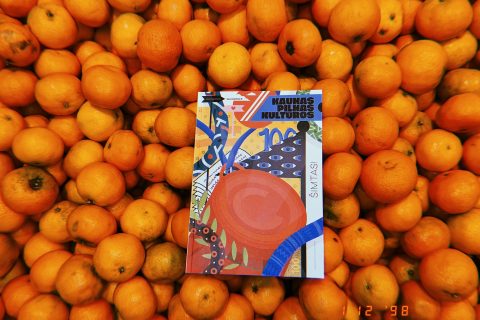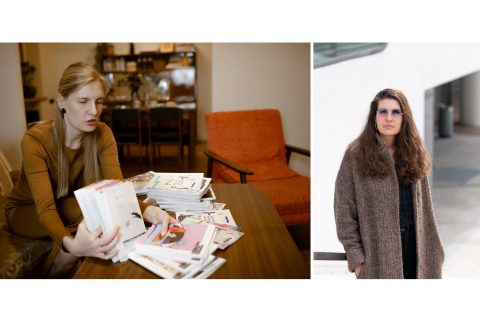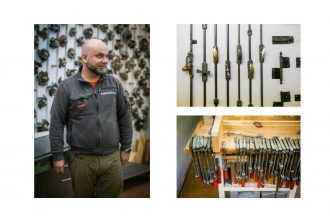“Everybody says so,” Timotiejus Norvila smiles after hearing how surprised my voice sounds when I learn that he will soon turn 38. Yes, the street artist who goes by the pseudonym of Morfai looks conveniently young. If, God forbid, he had ever drawn some illegal graffiti, no one would have ever suspected this babyface.
It would be weird if someone living or often visiting Kaunas declared they haven’t seen any of Morfai’s work. His artworks unlock facades, create new dimensions, come alive at night, tackle nature, and gently tap with a finger encouraging you to want more from everyday life. Although it is not an exaggeration to say that Timas’ canvas is the whole city, he does create paintings of smaller dimensions using spray paint (he prefers Montana) in his studio in the Pergalė factory. Only, he says that he hasn’t found a way yet to properly present them to future buyers. Maybe he will discover it during these holidays.
It is, in fact, rather strange that Kaunas Full of Culture did not introduce one of the most active members of the community of Kaunas ‘wallographers’ until its 100th issue. He has long lost count of the number of his works and does not have time to celebrate the completion of new drawings. A significant number of Morfai’s works are part of the Kaunas municipality’s project Kaunas Highlights and their realization is financed by the city. But there are older works by this author in Kaunas, sometimes unsigned. In other words, we could easily create a map containing only works created by Timas.

Our magazine is in its ninth year. When we started, you were already a well-known artist still in the underground circles. Which one of your works was the one that brought you more fame?
I think the most successful was Star Sower, a continuation of the sculpture by Bernardas Bučas; it happened around 2008. But then I tried to go incognito for a while, like Banksy, however the mystery got ruined. Kaunas is small and everyone knows each other, especially those who draw.
Have you been drawing since childhood?
I actually attended Kaunas Art Gymnasium, I only graduated from another school. My grades were poor, so I didn’t have a chance to get into the academy, but I got into college. I spent a year in the capital, although I took the lectures seriously only in the first semester. It felt like a waste of time, and I thought I’d better work on my own stuff. I dropped out, returned to Kaunas and started doing what I was really interested in. I didn’t study anywhere else after that. Yes, I was a bit of a burden for my parents, but that was my way.
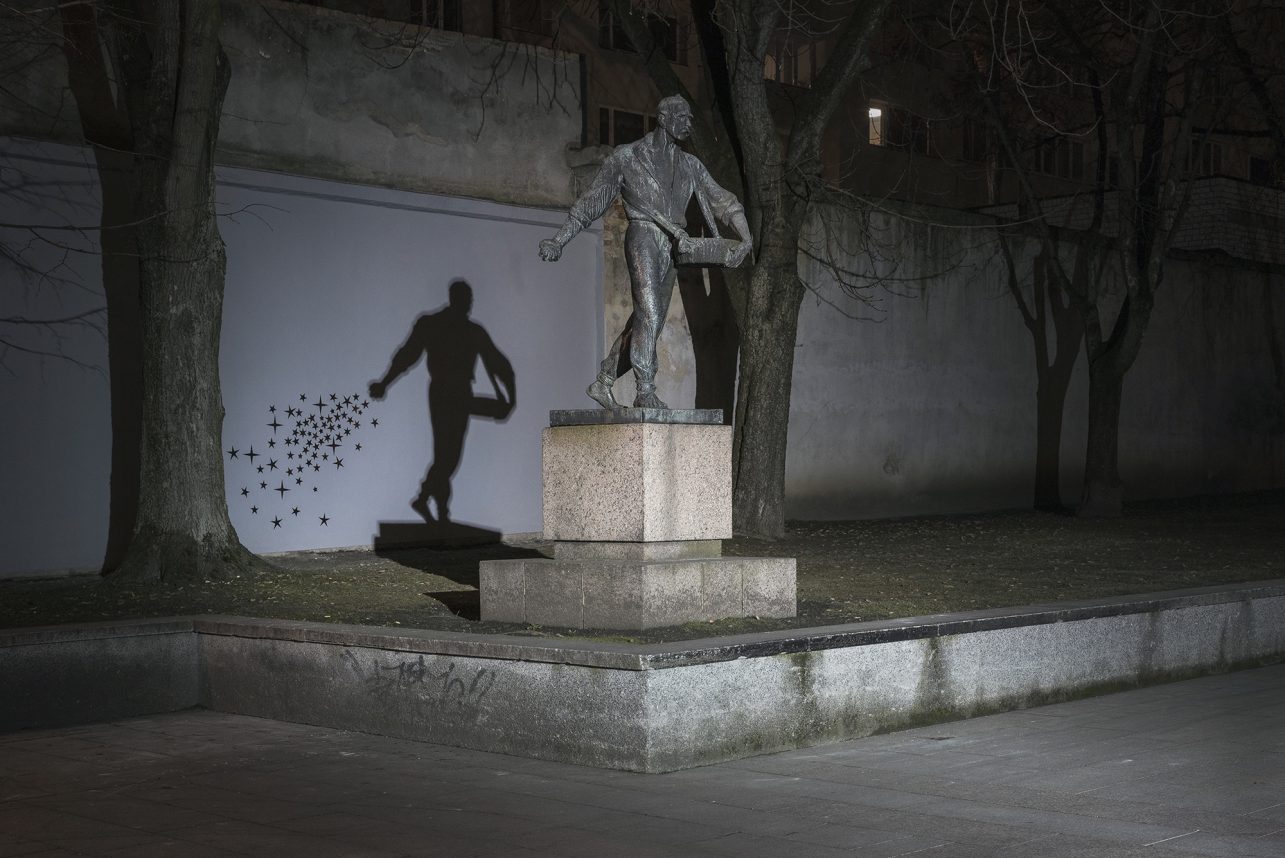
Your mother Vitalija, may she rest in peace, helped you a lot, right?
Yes, we have worked together in recent years, but now it is more difficult for me. The administrative part is a real hassle. My mother and I used to implement 3 – 4 projects a year, I created and drew, and didn’t have to worry about checks and reports. Now I manage to implement only one because I don’t want to feel exhausted. I want to create more and film a vlog about street art. I had released several episodes that I filmed while going to paint where I showed the behind-the-scenes. Now I’m preparing for a new one, about the Wall of Books, which is right here near my studio.
Yes, I saw the process of the Wall of Books. The protective walls separating the houses from the noisy street were gradually covered with the spines of books. Tell us more about this work.
I live near here, in Žemoji Freda. During the final year of Kaunas 2022, I was painting nearby on a wall of O kodel ne? bar and now this wall appeared. It’s nice to work in my area. I used to live on Trakų Street, I have always lived in the center. Near my childhood home, next to the mosque, you will find a trampoline I created in the place of an old fountain. It is important to take care of your environment. But, well, I also worked in Joniškis this year – they invited me there, I didn’t initiate it myself.
So, let’s get back to the Wall of Books. Book spines are an allusion to the fence panels because that whole wall looks like a fence. I drew three shelves. The smallest one is for contemporary Lithuanian literature, then goes the Lithuanian classics: Žemaitė, Vydūnas, and everything else. The longest one belongs to the world classics. This is a project of Kaunas Highlights financed by the city. That wall used to be legal, one of three of its kind, where graffiti was officially allowed. Of course, it was difficult to work there due to the intense traffic.
When I was preparing for the interview, my husband reminded me of the giant fire moon that you ‘stole’ and placed in the window openings of the Respublika Hotel. This might have been around 2015. The hotel was demolished a long time ago and a business centre was built in its place, but many people remember the moon and the snail you created next to it. What would you call such interdisciplinary experiments?
I would simply call it media. That moon in Respublika was not legal. The building was in a very bad state, it was all temporary. How did that idea come about? I wanted to do something in those empty buildings. I found some inspiration in Sielų upė (the river of souls), which is organized on All Saints’ Day in the center of Kaunas. People just line up candles and it looks like a runway. In general, I am always curious about the fact that you can create a maximum effect with minimal means.
Your works are always site-specific. How often do you have to walk down the same street before building facades or doorways start speaking to you?
Many times. But I am sure that photographers or architects would say the same thing. The same applies to me! I walk, observe the city, and develop a perspective and that perspective begins to dictate the content. For example, in the Old Town, there is a spot that I hang out at often, and recently a billboard was taken off one building, revealing a beautiful old door. My thoughts started racing immediately; I started thinking about things that could be done there.
I recently visited Rouen, France. It was difficult to find something to hold on to, everything was new to the eyes. Or Joniškis, where I recently finished a mural. I don’t know the town; I have never been there before. I was invited, so I looked it up on the internet and went to work immediately. And what do you know? I didn’t expect to find the bench bolted to the ground, without the possibility to move, so I had to crawl under it.
When, say, you drew the first Star Sower in the garden of the War Museum, you probably well understood that it was illegal and therefore temporary. How do you deal with the temporality of your works?
That’s the way it is. The new Wall of Books is already dirty, after all, it’s next to intense traffic. The world-famous creators have come to terms with this for the longest time. You go somewhere, paint a huge wall, come back a couple of years later, and that building is gone. You can also ask the architects how they feel about it [laughs].
Anyway, I think the most important thing is to document everything and then publish albums when the time comes. Yes, an online presence is important, but websites are disappearing, and paper albums will last forever.
More and more often, street art becomes a background for photo shoots. The newlyweds were especially keen on Vytenis Jakas’ Pink Elephant, and the wall by the railway bridge is also very popular. Of course, drawings are part of the fabric of the city, so it’s great that people choose to express their style in this way but not everyone indicates the author when the photographs are taken for commercial purposes. Or they only indicate the photographer’s name. What are your thoughts on it?
Yes, the drawings end up in tourist brochures, and guided tours. I think as long as it’s not commercial, it’s fine. It’s nice when a work takes on a life of its own. But if the drawings are used to make money and without consulting you, then it is wrong. This has happened to me once. In Vilnius, one car importer took a photo of a new model next to my composition with railway workers and posted it on Facebook. I am a member of LATGA, so I contacted them. He offered to take a ride in that car as compensation, but I don’t even live in Vilnius. In the end, he paid, albeit symbolically. By the way, in the USA, when filming a movie on the streets, graffiti is covered up. They just stick their drawings so that no one can make any claims.

I remember that a production team repainted the stairs of Pompėja, when they were filming a historical film in Kaunas because tags would have not existed in that particular period, but now the stairs are full of graffiti again. What is your opinion on tags?
I prefer more complex visions than incoherent markings. I’ve left a lot of them myself in the past. By the way, I saw one recently, but I am not a fan of tags anymore, I’m more of an aesthete. I am a rather traditionally minded, conservative. Of course, that shift in my perception didn’t happen overnight, but it happened. Gradually, I began to understand what beauty really is, and what its high standards and canons are. I would like my drawing to lean towards classical realism. Now I keep thinking: I would like the whole city to be neoclassical. Of course, the architects might condemn me, but… [smiles]
Does the wall of an apartment building in Vilijampolė, on Sąjungos Square, give meaning to this wish of yours?
It is more of a caricature, a comparison of two cardinally opposite eras and expressions of architecture. Maybe residential buildings don’t need as much decor as you can see in the drawing, but doing it for the sake of contrast, and caricature: why not?
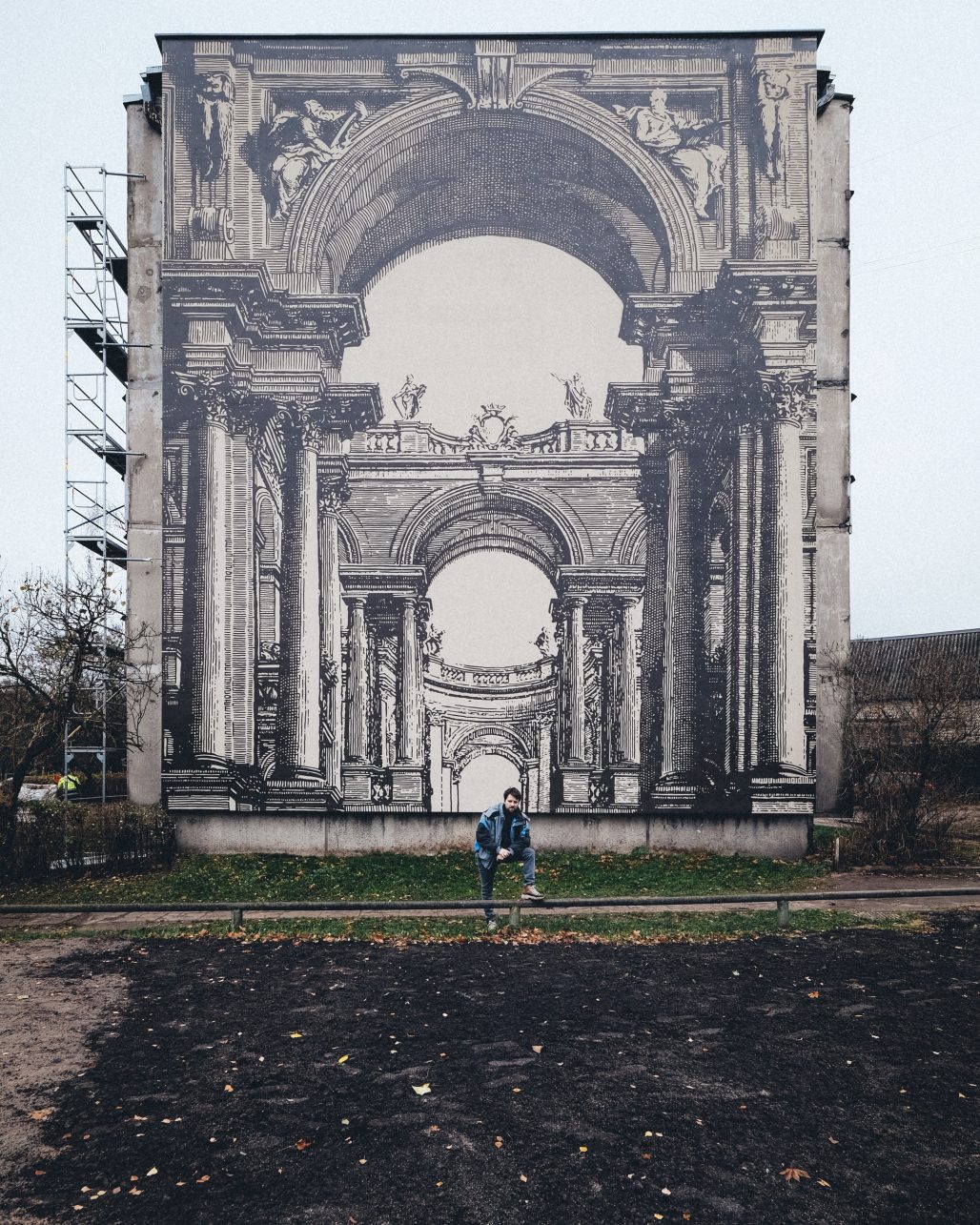
Do you think that the Kaunas of today could be more beautiful?
It should be, yes. Of course, when it comes to big objects emerging in the city, I’d say it’s great that they’re happening at all. There could be a long discussion about the visuals, the facades, but would anyone be better off without them?
Do you and your colleagues discuss each other’s work?
We have a smaller group on Facebook – Sienografų draugija (wallographers’ society) – where we discuss more important issues related to drawings. Of course, we also talk about it with friends face to face. Wider discussions also take place in a larger group called Streets of Kaunas, only it has gotten a bit silent now. I welcome everything because I still remember those sad times when nothing happened in a city as big as Kaunas. That snail or Respublika was a critical message to the vacuum, mocking the city that moved in such a slow pace. That is why I cannot complain now, even if the public object doesn’t quite fit my taste or worldview. Yes, it could be more interesting, but at least things are happening. It is way better than an empty space without any good suggestions.
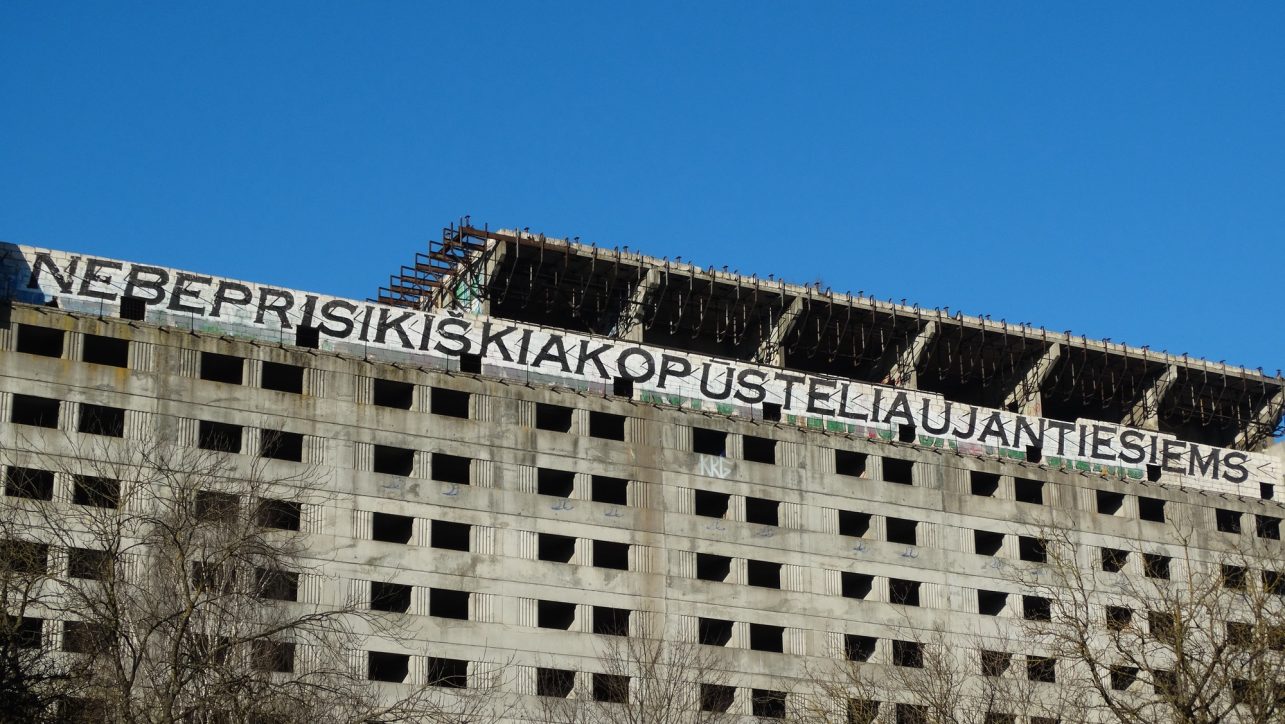
I wonder how people react to you drawing.
They usually are very interested and curious. They stop, ask questions, and say, ‘wow, I finally saw how those drawings appear.’ Locals wonder what will appear in their neighborhood. While I was working on the Wall of Books, a woman found a way to approach me and said, “It’s really nice that you’re drawing here.”
Each artist has their own rhythm. Some like to work in the morning others at night. In the street, the pace is probably dictated by the street itself, and the time of year.
Yes, every job has a different schedule. Here, on Čiurlionio Street, it is difficult to spend all day due to massive air pollution. In general, physical work is exhausting, so if there is an opportunity, it is better to draw fewer hours but more days. I remember when Karolis Grubis and I worked on the drawing of Kazys Varnelis in Vilnius, we only had 7 days because we had rented a lift (it would have been cheaper to use a ladder or scaffolding). The weather ended up being really pleasant, it did not rain, so all we did was work. Lunch, dinner, sleep, and drawing.
A few years ago, your idea – Lidija Meškaitytė’s watercolor – was transferred to the wall in Vilijampolė by an Estonian robot. Do you think there will be more such facilitations in the future?
It was interesting at the time to try it out. It is too expensive to completely replace manual labour. It hasn’t gotten cheaper in a few years [laughs]. But, of course, if I could afford it, I would definitely entrust the technical work to others. Then I would be able to create more.
How are the things with artificial intelligence?
Very interesting! I realized quite quickly that you have to put a lot of yourself if you want it to help you create a really unique and original work. For example, I dream of creating a work dedicated to Romas Kalanta. This is where artificial intelligence would help me, but I would also like assistance from someone who knows how to talk to it better. If such a person does not appear, I will have to learn it myself. I imagine a scene: Kalanta, a hippy, walking down Laisvės Avenue. Happy, carrying flowers. Such a photograph does not exist, his portraits are really small, but we could create such an image. I already have a spot for it, near the City Garden.
You know, I still don’t know how to properly pronounce your nickname. I’d accentuate the end (MorfAI) because it reminds me of the band Mogwai but perhaps I am wrong, and it is actually MOrfai?
Mogwai to you, Smurfs to others. It was MorfAI actually, but someone started saying MOrfai. I thought it sounded bad, but eventually, I started saying it myself. I was just looking for a word that wouldn’t be mentioned too many times on the internet, that it would be difficult to mix up when googling. For example, there is a band called The Internet. So how do you find their songs on the internet? Absolutely poor marketing decision! Well, I had such a strategy [laughs]. If we read it in Lithuanian, it might seem that it’s a group of those who would be called ‘morfas’ in singular form.
What work are you most proud of?
Now my favorite one is The Epic of the Crossing in Vilnius. I put a lot of love into it and the whole process was just great.
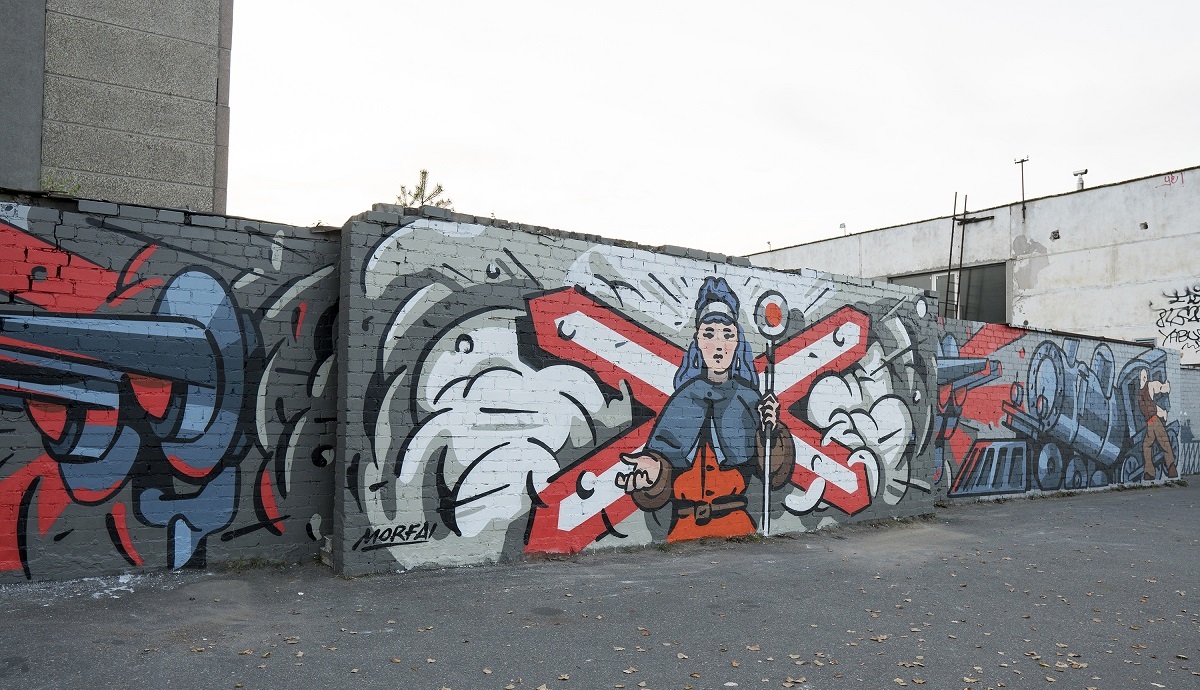
Hey, what about Kaunas? I can tell you which one is my favorite. It is the Nebeprisikiškiakopūsteliaujantiesiems on the Britanika Hotel. I always show it to guests from abroad and we all try to find the equivalent of this word in their language. After all, everyone has the longest words and the abandoned buildings that take ages to demolish.
Yes, that’s a good one. A successful one. It is a nice word, referring to a plant. I immediately imagine someone going to pick wood sorrel (in Lithuanian wood sorrel is kiškio kopūstai, which translates into ‘rabbit’s cabbages’, ed.). I can point out my favorite in Kaunas, but it will not be a drawing and it will not be mine. It is a public art object. I am talking about the Juozas Zikaras’ Freedom Monument. It is my number one object in Lithuania. Everything created by Zikaras is amazing.

